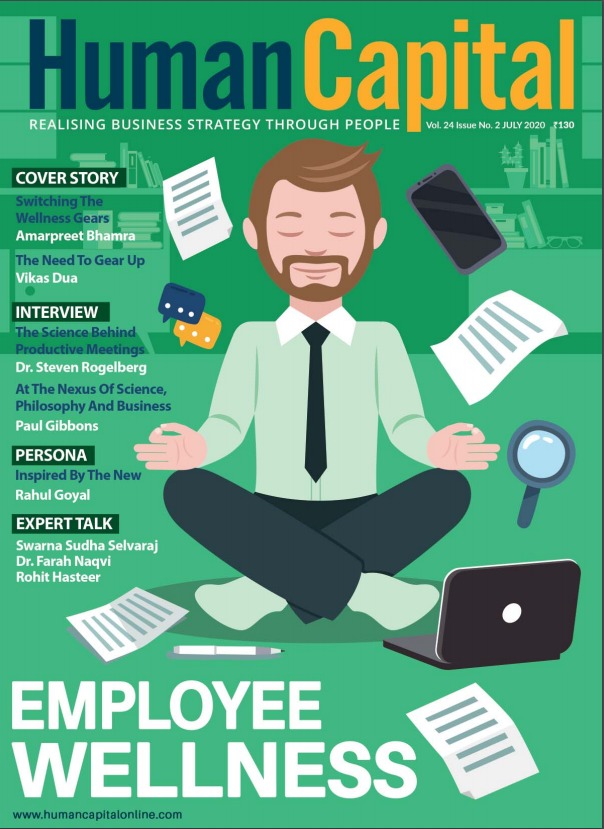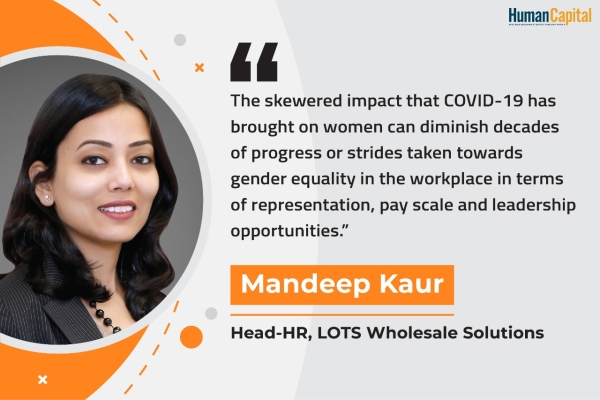As we take a look over the past two years, we find that women in the workforce have borne the brunt of the pandemic and suffered long term effects…
Meera Singh, a single mom of two children, is used to stretching her income. Her salary as a spa manager in a leading chain of hotels paid for her children’s education, healthcare, daily needs, emergencies, and more. She does everything she can to provide the best possible life to her kids. For her, life is a struggle. But it took a turn for the worse when she was laid off a few months into the pandemic in 2020.
Meera’s story is one among countless women who were hugely impacted due to the economic crisis brought on by the COVID-19 pandemic. Unfortunately, the pandemic was harsher on women, with 55% of unemployed people being women, as per a study conducted by Deloitte. My personal experience corroborates this.
Over the last few months, I have encountered several women who have had to take sabbaticals or completely give up their careers as a result of the pandemic. Interestingly, several men have also revealed that their spouses who were previously working in well-paying jobs and positions in private firms had to give up their jobs and their positions and prioritise due to the pandemic and tend to responsibilities at home.
Unlike other economic downturns in the past that have largely affected men, this one has distressed women more, leading to what has been coined as a ‘pink recession.’ Amidst all of the impact of the pandemic, that continues to be felt globally this one perhaps is the saddest. It has undoubtedly set women back in their empowerment and financial independence journey by many, many years.
What Is A Pink Recession?
A pink recession or she-cession (it is quite strange how “pink” has become a sexist colour; as I prefer gender-neutral colours, please humour me and let’s go with the latter) is a chaos-induced and extremely stressful output of the COVID-19 pandemic. In addition to numerous women losing their livelihood as the world shut down, it also immensely increased the burden on women in the workforce. Not only do they have to perform their jobs in today’s new normal of ‘work from home,’ they are also buckling under the pressure of running their households and catering to the needs of every family member, including home-schooling, looking after aged parents and more.
She-cession has led to more and more working mothers putting their careers on the back burner. In order to stay afloat, we are seeing women cutting back their work hours drastically or leaving the workforce altogether for the lack of proper infrastructure or support to manage personal responsibilities. In order to put their family first, women are letting go of their dreams, hopes, and financial independence.
As per a report by the Centre for Sustainable Employment at the Azim Premji University, during the first wave of the pandemic, 47% of women lost their jobs compared to only 7% of men. The impact on rural India was even more catastrophic, with over 80% of women losing their livelihood in the informal sector, many of whom are yet to return to work. The already abysmal participation of women in the workforce has shrunk to a decade low to 11%. Women also spend a significantly longer time doing unpaid care work at home, including domestic chores and caring for children and the elderly. It is estimated that during the pandemic, their unpaid workload grew by over 30%, as per a report by the Centre for Monitoring Indian Economy (CMIE).
This skewered impact that COVID-19 has brought on women can diminish decades of progress or strides taken towards gender equality in the workplace in terms of representation, pay scale and leadership opportunities.
How Can You Reverse The She-Cession And Drive Progress?
Despite husbands and dads now starting to share responsibilities with their better halves, we cannot hide from the fact that women continue to be the primary caregivers and house managers. They continue their attempts to be superhumans and juggle everything from ensuring that the kids are ready for school online, the house is well stocked, the husband gets what he needs, the elderly have their needs taken care of and everyone is well-fed. The pandemic further added the concern of ensuring everyone was safe and protected from the virus at all times.
In such a high-strung and stressful situation, the onus lies on employers to provide proactive support and mitigate burnout of their women workforce. So, the vital question is, what can companies, and in effect HR leaders, do to lessen the burden on the workforce and create a sustainable environment to make life a little more manageable?
Show empathy: These are challenging times for everyone. We may not always know what the other person is going through. It is, hence, imperative to show kindness and empathy to all employees, especially women. Listen to them, understand their challenges and ask them how you can help. Create a safe environment for them, so they are not always stressed about their performance and if that will negatively impact their place in the organisation. Most importantly, acknowledge their struggle as working mothers and let them know they can reach out to you for anything.
Provide flexibility in the true sense of the word: Everyone is dealing with different issues. Therefore, it is essential to understand the concerns of your women workforce and try your best to accommodate them. This could mean giving them the flexibility to schedule their workday, prioritizing projects, creating a community where team members can share workloads, giving more sick leaves, etc. For example, if an employee has young kids that attend school till 12 PM and they are required to sit with them, you can give them the flexibility to join work after that. Or, if someone is dealing with a personal crisis, another team member can relieve them by taking over for some time.
Enable support: Your employees may be facing unimaginable challenges such as mental stress, domestic violence, caring for a child with special needs, etc. Offer them all the coping tools and support you can to make their lives a little more manageable. For example, you can provide therapists to talk to, connect them to welfare organizations, or make self-care opportunities available. You can also offer cleaning services if they are too stretched or give them a stipend for child/elder care. I strongly believe that support should not only come from HR but also managers and colleagues. It is hence imperative to build a peer support system where people are checking on each other and just being there for them.
Empower women to succeed: As the pandemic shows signs of coming to an end, it is crucial that HR professionals focus on the growth and development of their women employees to enable ‘she-covery.’ This could include offering them learning opportunities to upskill them, giving them diverse projects to expand their experience and expertise, and putting them in leadership roles to help them climb the ladder. Moreover, companies and their leaders need to demonstrate a strong commitment to reversing the she-cession and building gender equity. They can do this by hiring more women, ensuring pay transparency, improving worklife balance and building a thriving workplace for their employees.
As the businesses look at mitigating the long-term impact of the COVID-19 pandemic, it is time to adopt a new approach by first seeking employees with diverse skill sets and making a conscious effort to cultivate a more inclusive workforce for women in 2022 and beyond. While COVID-19 has brought on the she-cession crisis, the effort to recover from it doesn’t end with the pandemic. The businesses must take initiatives to future-proof their employees and business from other such disruptions.
Has COVID-19 forever changed the way we live and work?
Trending
-
SBI General Insurance Launches Digital Health Campaign
-
CredR Rolls Out 'Life Happens' Leave For Its Employees
-
Meesho Announces 30-Week Gender-Neutral Parental Leave Policy
-
Microsoft Unveils Tech Resilience Curriculum To Foster An Inclusive Future
-
60% Indian Professionals Looking For Job Change Due To COVID: Survey
-
SpringPeople And Siemens Collaborate For Digital Transformation Push
-
86% Professionals Believe Hybrid Work Is Essential For Work Life Balance: Report
-
Almost 1 In Every 3 People's Personal Life Affected Due To Work Stress
-
Meesho Rolls Out Reset And Recharge Policy For Employees
-
80% Of Talent Leaders & Academics Say Pandemic Changed Skill Needs For Youth: Report
-
Hero Electric Rolls Out 'Hero Care' Program For Employees
-
Human Capital In Collaboration With ASSOCHAM Hosts Virtual Conference
-
IKEA India, Tata STRIVE Collaborate To Create Employability And Entrepreneurship Opportunities
-
SAP India, Microsoft Launch Tech Skilling Program for Young Women
-
DXC Technology, NASSCOM Collaborate For Employability Skills Program
-
Lenskart To Hire Over 2000 Employees Across India By 2022
-
Mindtree Launches Learn-and-Earn Program
-
Tata AIA Extends 'Raksha Ka Teeka' To Its Employees
-
Swadesh Behera Is The New CPO Of Titan
-
NetConnect Global Plans To Recruit 5000 Tech Professionals In India
-
Hubhopper Plans To Hire 60% Of Indian Podcasters By 2022
-
Corporate India Needs More Women In Leadership Roles: Report
-
Aon to Invest $30 Million and Create 10,000 Apprenticeships by 2030
-
Tech Mahindra Launches ‘Gift a Career’ Initiative for Upskilling of Youth
-
40% Women Prefer Flexible Working Options in Post-COVID World: Survey
-
3 out of 4 companies believe they can effectively hire employees virtually: Report
-
Vodafone , CGI and NASSCOM Foundation launch digital skills platform
-
Odisha: Bank, postal employees to deliver cash for elderly, differently-abled persons
-
Skill India launches AI-based digital platform for "Skilled Workforce"
-
Hiring activity declines 6.73% in first quarter: Survey
-
70% startups impacted by COVID-19 pandemic
-
Bajaj Allianz Life ropes in Santanu Banerjee as CHRO
-
Over 70 Percent MSMEs look at cutting jobs to sustain businesses
-
93 Per Cent employees stressed about returning to office post-lockdown
-
Johnson & Johnson India announces family benefits for same gender partners
-
Indian firms turning friendly towards working mothers
-
Welspun India names Rajendra Mehta as new CHRO
-
Wipro partners with NASSCOM to launch Future Skills platform



Human Capital is niche media organisation for HR and Corporate. Our aim is to create an outstanding user experience for all our clients, readers, employers and employees through inspiring, industry-leading content pieces in the form of case studies, analysis, expert reports, authored articles and blogs. We cover topics such as talent acquisition, learning and development, diversity and inclusion, leadership, compensation, recruitment and many more.
Subscribe Now












































Comment